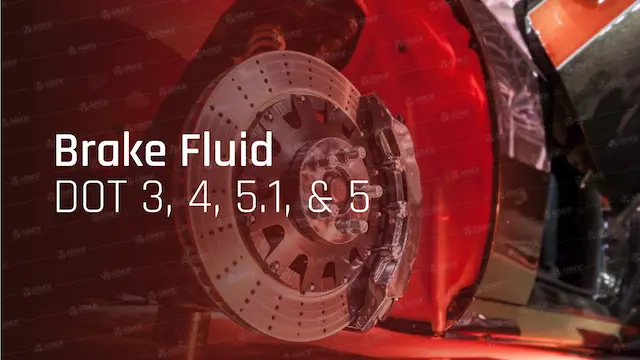- Armor Blog
- Products
- Key Differences of DOT 3, 4, 5.1 & 5 Brake Fluids Performance

Brake Oil, a specialized fluid, plays a key role in the braking process by transmitting the force from the brake pedal to the brake pads, ensuring efficient stopping power.
It can also have properties such as lubrication and anti-corrosion, which enhance the functionality and longevity of the braking system. Therefore, selecting the right brake oil is a critical aspect of maintaining a vehicle.
Various types of brake fluids are designed to meet the needs of different braking systems. The most common ones on the market today are DOT 3, DOT 4, DOT 5, and DOT 5.1 fluids.
Are they the same? Do they have massive differences? What sets these specialty fluids apart from others? Allow us to answer all your questions.
What are the Main Characteristics of Brake Fluid?
The braking system experiences high temperatures during operation, requiring the brake fluid to have specific qualities in order to function effectively. Additionally, its primary characteristics are:
- Non-compressibility: They should be resistant to compression to efficiently transfer force to the brakes.
- Low viscosity: This is important for cars with ABS.
- Lubricity: for lubricating seals in the braking system, certain additives are used to enhance the lubrication properties of the fluid.
- Corrosion resistance: in order to safeguard braking system parts.
- High boiling point: for withstanding extreme temperatures and preventing vaporization that could impede the transmission of braking force.
What is the Definition of DOT?
DOT is an acronym for the Department of Transportation in the United States. it is commonly used to denote the levels of brake fluid that are mandated by the Federal Motor Vehicle Safety Standards (FMVSS), namely DOT 3, DOT 4, DOT 5, and DOT 5.1.
DOT is a common classification, but not the only one. There are others such as J1703, J1704, and J1705, which are defined by the Society of Automotive Engineers (SAE), as well as the ISO 4925 standard’s classes 3, 4, and 5, and 5.1.
Brake Fluids Composition
Regardless of the brand, brake fluid has 3 main components:
- A solvent
- Lubricating agents
- Additives
The solvent makes up the majority of the fluid (ranging from 60% to 90%), while the lubricating agents make up 5% to 30%, and the additives only make up 2% to 5%.
These additives serve specific purposes, such as corrosion inhibitors that protect the metal parts of the brake system from corrosion and antioxidants that prevent the breakdown of the solvent and the formation of deposits.
GLYCOL-BASED Brake Fluids
DOT 3 Fluid utilizes glycol ether as a solvent and is a traditional brake fluid that has been commonly used in vehicles manufactured prior to the 1990s. It is compatible with all types of brake systems and can be used in any driving situation. Everything You Need to know about Dot 3 Fluid. Read this Blog.
DOT4 contains glycol ether and borate ester compounds that enhance its effectiveness in comparison to DOT 3. It has become the standard for cars made after 2006. Similar to its forerunner, it is appropriate for all types of brake systems and driving situations. Everything You Need to Know About Dot 4 Synthetic Brake Fluid, Read this Blog.
DOT 5.1 contains glycol ether and borate ester compounds, providing superior performance similar to that of the silicone-based DOT 5. It can be considered a non-silicone alternative to DOT 5, while still being compatible with DOT 3 and DOT 4 braking systems and fluids.
It is important to handle all brake oils that contain glycol with caution, as they have the potential to harm the paint of a vehicle or motorcycle.
SILICONE-BASED Brake Fluids
DOT 5 fluid is made with silicone, which means it is not suitable for use in anti-lock braking systems. It is also important to note that DOT 5 cannot be mixed with other types of brake fluid. Unlike other fluids, it will not harm the paint on your vehicle.
The liquid is specifically designed for challenging uses such as military transportation and extremely low temperatures.
Is it Possible to Combine Different Brake Fluid Types?
The rule is not to mix brake fluids; it is always better to use the brake fluid that is recommended by that manufacturer. However, there are some exceptions to every rule.
Mixing brake fluids is only possible if the added fluid is of a higher grade than the existing fluid in the system.
For instance, a braking system that is designed for a specific brake fluid specification, such as DOT 3, can also accommodate the use of either DOT 4 or DOT 5.1 fluid. You can top up a system equipped with DOT 4 with Dot 5.1 fluid without requiring a bleeding process.
It is important to note that a DOT 4 brake system should never be refilled with DOT 3 brake fluid. This is because the lower dry and wet boiling points of DOT 3 fluid will not be sufficient to meet the necessary temperature requirements.
Do not add DOT 5 brake fluid to any other type of fluid due to its silicone-based formula.
To achieve the best performance from your braking system and brake fluid, it is recommended to bleed the brake fluid and replace it with a new one.
Dry and Wet Boiling Points: What are they? And Why Should you Care?
The difference between braking fluids is determined by their dry and wet boiling points. These terms refer to the temperatures at which the braking fluid boils when operating.
The dry boiling point is the temperature before the braking fluid becomes contaminated or absorbs moisture. The wet boiling point describes the fluid’s properties after a given period of time in the system and exposure to ambient conditions.
The types of braking fluids, namely DOT 3, DOT 4, and DOT 5.1, are characterized as hygroscopic due to their ability to absorb water. This is the reason why they have two different boiling point values.
In contrast, DOT 5 is made of a hydrophobic silicone formula that repels water, resulting in more consistent boiling points.
Conclusion
In conclusion, choosing the right brake fluid depends on your vehicle’s requirements and driving style. DOT 3 and DOT 4 Brake fluid are the most common choices, with DOT 5.1 offering higher performance. Always refer to your vehicle’s owner’s manual or consult with a professional if unsure. Remember, never mix DOT 5 with other fluids as this compromises braking performance.
Buy Premium Brake Fluid from Armor Lubricants
Armor Lubricants is the best premium brake fluid manufacturer in UAE. Experience superior performance and protection with Armor Lubricants. As a leading supplier of brake fluid, we offer a brake fluids at the best prices in UAE to meet your specific needs. Visit us to be the exclusive distributor for the best quality lubricants which meets and exceeds international standard specifications provides exceptional performance.




 Spear Lubricants
Spear Lubricants Armada lubricant
Armada lubricant Ace lubricants
Ace lubricants Perfect lubricants
Perfect lubricants Enzo lubricants
Enzo lubricants Lawrence lubricants
Lawrence lubricants